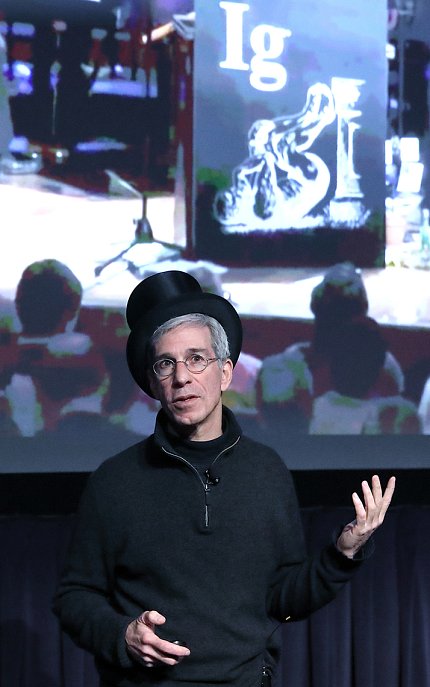‘Ig Nobel’ Prizes Reward Funny, Thought-Provoking Science

Photo: Chia-Chi Charlie Chang
Dead magnetized cockroaches behave differently than living magnetized cockroaches. Pizza might protect against illness and death—if the pizza is made and eaten in Italy. A typical 5-year-old child produces 500 ml of saliva per day. These are just a few of the research findings awarded Ig Nobel Prizes in 2019.
Ig Nobel Prizes honor achievements “that are so surprising that they make people laugh and then think,” said Marc Abrahams, founder of the annual Ig Nobel Prize ceremony and editor of the magazine Annals of Improbable Research, at the Feb. 19 Wednesday Afternoon Lecture in Lipsett Amphitheater.
The magazine has awarded 10 Ig Nobel prizes each year since 1991. Award recipients are offered the prize in secret. Recipients can decline if they like, but “happily, almost everybody who’s offered a prize accepts,” said Abrahams. Quite often, the recipients don’t realize that what they’ve done is funny, although “everyone else does.”
Winners travel at their own expense to a ceremony at Harvard’s largest auditorium, Sanders Theater. There, real Nobel laureates present Ig Nobel awardees with their prizes. Every winning team gets 10 trillion Zimbabwean dollars.

Photo: Chia-Chi Charlie Chang
“If you win an Ig Nobel Prize, you will almost certainly get a lot of attention from a lot of journalists around the world,” Abrahams said. “Please take advantage of it any way you can.”
Over the years, the ceremony has picked up several traditions, he explained. Attendees toss paper airplanes in the auditorium. An 8-year-old girl named “Miss Sweetie Poo” yells “Please stop, I am bored” if an acceptance speech goes on past its allotted time. She won’t stop until they do “and it works!” Since 1996, professional opera singers, accompanied by Nobel laureates, perform a three- or four-song opera.
In addition to being funny, Ig Nobel awards also make people think. Abrahams said these awards stick in people’s minds. “All they want to do for the next week is talk it about with their friends,” he said.
In 2009, Dr. Elena Bodnar and her colleagues received the Ig Nobel Public Health Prize for designing a bra that could be quickly converted into a pair of gas masks, “one to save your life, one to save the life of some lucky bystander,” said Abrahams.
Bodnar, who grew up in Ukraine, was one of the doctors who treated patients after the Chernobyl nuclear accident in 1986. The meltdown triggered the release of radioactive particles into the air. She wondered why protective masks weren’t available. She got the idea for her invention after seeing her infant son put a bra on his face.
In 2018, Dr. Akira Horiuchi received the Ig Nobel Medical Education Prize for developing a self-colonoscopy to be administered in the sitting position. The doctor noted that, in Japan, colonoscopies are not common medical procedures. As a result, most of the kinds of cancer caught early in developed countries are not caught early in Japan.
Abrahams estimates that his magazine receives 10,000 nominations per year. Consistently, 10-20 percent of these are self-nominations, which seldom win.
“Anybody who has ever started something purely to win an Ig Nobel prize has failed,” he said. “It’s close to impossible to manufacture something intentionally that has that double quality of striking anybody as funny and making anybody curious at the same time.”

Photo: Chia-Chi Charlie Chang
Abrahams concluded his talk the same way he concludes the ceremony each year: “If you did not win an Ig Nobel this year, and especially if you did, better luck next year.”
The full list of 2019 Ig Nobel Awards can be viewed at https://www.improbable.com/ig-about/winners/#ig2019.
